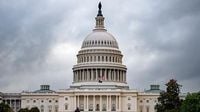In a dramatic turn of events amid a deepening U.S. government shutdown, a federal judge has temporarily blocked the Trump administration from laying off thousands of federal workers—an explosive move that has sent shockwaves through Washington and beyond. The ruling, handed down by U.S. District Judge Susan Illston in San Francisco on October 15, 2025, comes just as the shutdown entered its 16th day, with Congress still deadlocked and no end in sight.
The shutdown, which began on October 1, was triggered by a budget impasse in Congress, primarily over disagreements on healthcare funding and federal spending cuts. Democrats, determined to extend Affordable Care Act premium tax credits set to expire, sought to protect millions of Americans’ healthcare subsidies. Republicans, backed by President Donald Trump, opposed these extensions and pushed for sweeping reductions in federal spending—including plans to cut the federal workforce by as much as 20–30%. The passage of the Rescissions Act of 2025, which slashed billions from international aid and public broadcasting, only heightened tensions between the two parties.
As the shutdown dragged on, the Trump administration began implementing layoffs across more than 30 federal agencies. Notices went out to approximately 4,000 employees, with the Department of Education, the Environmental Protection Agency (EPA), and the Centers for Disease Control and Prevention (CDC) among the hardest hit. According to a filing from the Office of Management and Budget (OMB), over a quarter of the cuts were to be made at the Treasury Department, which sent layoff notices to about 1,446 workers. Major departments such as Treasury and Health and Human Services confirmed on October 10 that they were issuing these notices, while Homeland Security announced layoffs at its Cybersecurity and Infrastructure Security Agency.
But the administration’s aggressive approach soon faced a formidable legal challenge. Two unions—the American Federation of Government Employees (AFGE) and the American Federation of State, County and Municipal Employees (AFSCME)—filed a lawsuit, arguing that the layoffs amounted to illegal political pressure and violated federal law. The unions contended that workers were being targeted simply because of their association with programs favored by Democrats, with President Trump himself stating that these programs were “never going to come back, in many cases.”
Judge Illston’s ruling was unequivocal. In her strongly worded order, she wrote, “The activities that are being undertaken here are contrary to the laws. You can’t do this in a nation of laws.” She further criticized the administration for assuming that “all bets are off, the laws don’t apply to them anymore, and they can impose the structures that they like on the government situation that they don’t like.” The temporary restraining order, effective immediately, halts all layoffs and prohibits agencies from taking any further action to administer or implement reduction-in-force notices during the shutdown.
The judge’s decision was shaped by the unions’ arguments and the real-world impact on federal workers. Many employees, already reeling from a tumultuous year, faced uncertainty about their health insurance and pay. Some pregnant workers worried they wouldn’t have coverage when their babies arrived, and others missed crucial layoff notices because they had been told not to check their work email during the shutdown—or found themselves locked out due to expired passwords, with IT staff furloughed. Judge Illston described the administration’s actions as “arbitrary and capricious,” stating it was clear they were proceeding without fully considering the consequences.
The administration, for its part, justified the layoffs as a necessary means to reduce bureaucracy, cut costs, and align federal agencies with its policy goals. OMB Director Russ Vought, in a White House interview, said the administration was targeting more than 10,000 layoffs during the shutdown. “We want to be very aggressive where we can be in shuttering the bureaucracy, not just the funding,” Vought said. He singled out programs like the Green New Deal initiatives at the Department of Energy and environmental justice efforts at the EPA as targets for layoffs.
The legal battle is far from over. Judge Illston’s order is a temporary measure, typically lasting two weeks, with another hearing scheduled for October 28 to consider whether the layoffs should be halted indefinitely. The Trump administration is expected to fight the pause all the way to the Supreme Court if necessary, especially given the high stakes and the precedent such a ruling could set for future shutdowns.
Meanwhile, the shutdown’s effects are rippling across the nation. Many federal workers are toiling without pay, even as President Trump tapped unused research and development funds from the Defense Department to cover military salaries. FBI agents will continue to receive pay, according to Director Kash Patel. In a rare move, Department of Homeland Security Secretary Kristi Noem announced that U.S. Coast Guard members would also get paid during the shutdown, thanks to what she called an “innovative” funding solution—though details remain scarce.
On Capitol Hill, the political standoff continues. The Senate has failed nine times to advance a GOP-backed funding bill already passed by the House, with the latest vote tally at 49-45. Notably, two Democrats broke ranks to support the bill, while Senator Rand Paul voted against it. Senate Majority Leader John Thune left the door open for another vote by strategically switching his vote to “no.” Some senators, including Pennsylvania’s John Fetterman, were absent from the vote despite previously supporting the bill. The legislative agenda remains packed, with judicial nominations and Department of Defense appropriations also on the docket.
Democrats, led by Chuck Schumer and Patty Murray, have lambasted the shutdown as a “health care shutdown,” highlighting its impact on essential services and calling for Republicans to return to the negotiating table. “As we speak – right as we speak – families are getting letters for their new health insurance rates,” Schumer said, criticizing Republicans for letting tax credits expire. Republicans, however, insist that now is not the time to negotiate on extending Obamacare tax credits or repealing Medicaid changes. House Speaker Mike Johnson has predicted the shutdown may become the longest in history, stating he “won’t negotiate” with Democrats until they “hit pause on their demands.”
The deadlock reflects the deep divisions in Washington, with both parties unwilling to fully compromise. As the shutdown drags on, millions of Americans are feeling the strain, federal services are delayed, and the nation’s economic and social stability hangs in the balance. All eyes are now on the courts and Congress as the next chapter in this high-stakes standoff unfolds.
As the clock ticks, federal workers, policymakers, and everyday Americans are left waiting for a resolution—one that remains elusive for now.






